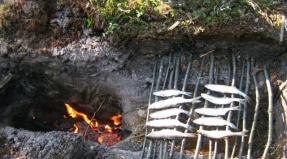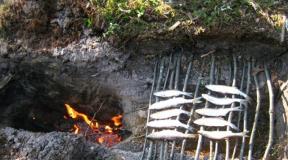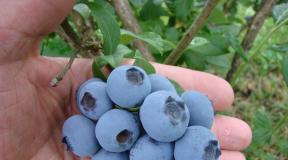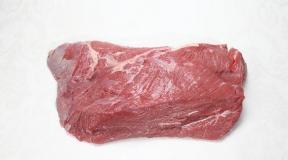Do-it-yourself artificial stone. How to care for stone cladding during use? What are the advantages of decorative stone over other materials, such as its natural counterpart?
Modern composite materials have many advantages, but they also have their disadvantages. The disadvantages of artificial stone will be discussed in this article.
The popularity of artificial stone products in last years only growing. Manufacturers of sinks, countertops, kitchen and dining tables, bar counters vying with each other to advertise its amazing capabilities.
Much of these statements are true.
They are strong and durable. Composite materials are valued for their beautiful appearance and rich decorative possibilities. They have an incredible palette of colors and a huge variety of textures. Artificial stone produces monolithic, smooth countertops of any shape without visible joints or seams.
But both types of artificial stone (acrylic and agglomerate) have a common drawback - high price. In terms of cost, they are clearly inferior to more affordable materials from which kitchen countertops are made - laminated chipboard, MDF, ceramic tiles, porcelain stoneware, stainless steel and even solid wood. Perhaps only tops made of natural quartz, marble or granite will cost more than them.
A beautiful kitchen countertop or a long bar counter made of artificial stone will cost several tens of thousands of rubles, depending on the type of material, manufacturer’s brand, color and shape of the product.
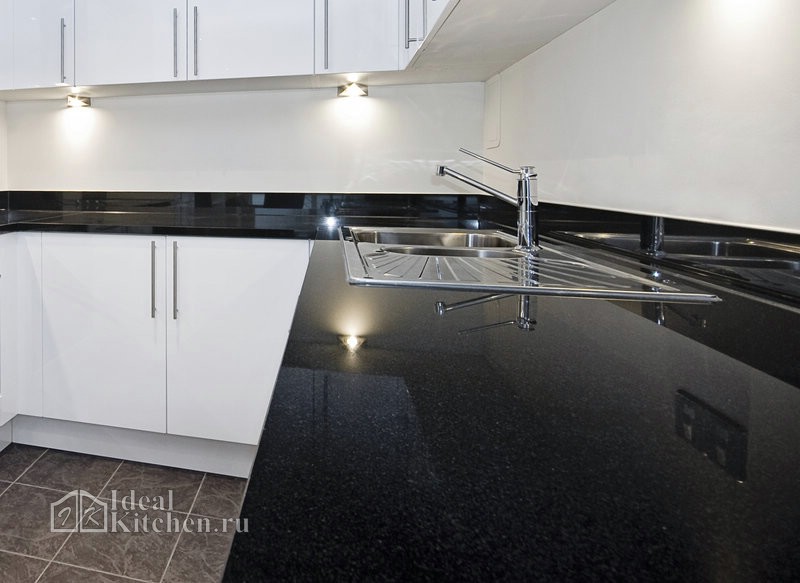
Disadvantages of acrylic stone
Acrylic stone is a modern polymer consisting of mineral particles, coloring pigments and acrylic resins.
The problem with all brands of this material is that it scratches quite easily. Scuffs and defects are especially noticeable on plain glossy countertops. The most capricious colors in this regard are dark ones: black, dark gray, chocolate...
A reasonable compromise is to choose a light shade of acrylic that will show less scratches. From this point of view, light gray and beige shades are especially good. It’s good if the tabletop has a grainy pattern or a rich “stone” texture, stains, inclusions.

Another disadvantage of acrylic countertops is that they cannot withstand high temperatures. If you place a hot pan on such a surface, a noticeable mark will appear on it, for example, a whitish spot.
In fairness, it is worth noting: countertops made of all types of acrylic can be easily restored right on site. In this case, there is no need to dismantle the top. After polishing, scratches and abrasions disappear and the surface looks like new. Almost all companies that manufacture artificial stone products offer this service for a small fee.
Cons of agglomerated stone
Agglomerate is an artificial stone made more than 90% from crushed chips of natural stone (most often granite, quartz or marble). Quartz sand, mirror or glass particles and special organic pigments-dyes are also added to it. Polyester resin acts as a unifying base. It is this combination of components that gives the agglomerates their exceptional strength.

Countertops made of agglomerated stone look expensive and impressive, and are much more affordable than natural stone. But agglomerate is a dense and heavy material: labor-intensive to process and difficult to install.
Some customers complain that agglomerated composite feels cooler to the touch than acrylic-based stone. However, this opinion is subjective - natural stone will seem even colder to the touch.
Agglomerate is a dense and durable stone. Unlike acrylic, it cannot be scratched by cutlery. Some manufacturers claim that on such a countertop you can cut food without a cutting board. Theoretically, hot dishes can be placed on agglomerated marble, quartz and granite: if the material is of high quality, there should be no marks left.
But despite this, he is still afraid of abrasive detergents. Because of them, micro-scratches may also appear on the polished surface. Over time, they can deprive the work surface of its beautiful shine. Polishing agglomerated stone is a rather complex process that requires special equipment and preparation. However, it is possible to restore its beautiful shine.
When placing an order for a countertop, table or bar counter, carefully read the clauses in the contract about the conditions of use of the material. Knowing what weak spots your specific countertop may have, you can keep it looking good longer and avoid potential manufacturer warranty issues.

Immediately after installing the stone countertop, experts advise rubbing the surface with a special protective agent. Its task is to enhance the water- and grease-repellent properties of the stone. For regular maintenance, it is recommended to use neutral detergents without abrasive particles, alcohol or acids. It is also advisable to avoid hard brushes.
What associations do you have when you hear the words " masonry"? Reliability? Comfort? Solidity? Beauty?
If we had lived several centuries in the past, the “cold” would probably have come to mind, but we were lucky and, as a rule, there are no problems with heating.
However, houses are not built from stone either, but wall cladding is not a problem. And if you still doubt why you should choose stone cladding, we will tell you about its advantages.
Aesthetics - the attractiveness of a particular material, is a matter of purely personal preference. But the variety of varieties and the possibility of creating artificial stone can please the most demanding taste.
Strength and durability - stone, both artificial and natural, is a strong and durable material. Neither wood nor siding (even vinyl) can compete with it in strength and ability to maintain its original appearance.
Fire resistance - this factor is very important, even if you choose just cladding. The less flammable materials there are in the architecture, the greater the chances of keeping your house intact in case of trouble.
Presentable - and we must not forget that stone has been considered an expensive and elite material since ancient times. Culture has conveyed this knowledge to our times, so the stone will do an excellent job of both making an impression and creating a special atmosphere.
But we must not forget about all the possible variety of stone, which is truly amazing.
Diversity
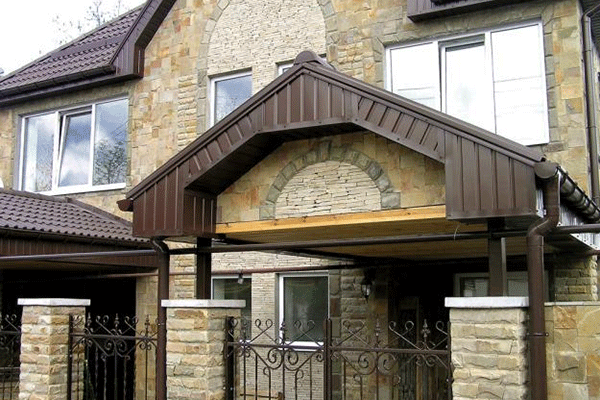
One of the ways of dividing: artificial and natural stone. However, this has almost no effect on the aesthetic characteristics, it’s just that the natural one is created from the processing of natural stone - no matter how surprising it may sound, while the artificial one imitates the color and texture of the real thing.
Practical differences between natural and artificial stone
In density: artificial stone is made using different technologies, but some types of natural stone will be harder - for example, dolomite, or softer - sandstone. This way the artificial stone will be lighter.
In thermal conductivity: made primarily from concrete with impurities, artificial stone has lower thermal conductivity - that is, it will retain heat.
In variety: artificial stone can take on the pattern that the customer wishes, but you will have to compare it with natural “sources”.
Types of stone
The division into species is much more interesting. Not many “grades” of stone are used in the cladding of houses during their construction, but even within one such “grade” there can be impressive differences, both in color and texture.
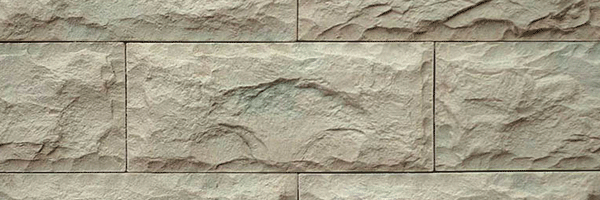
Types of facing tiles
In addition to the type of stone, it makes sense to take a closer look at the type of facing tile - this is the form in which the stone is processed. And there are a great many of these forms!
| View | Description | Image |
|---|---|---|
| Flagstone | Flat stone slabs of various shapes | 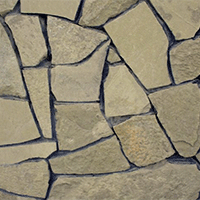 |
| Breccia | Flat plates of various shapes from rocks |  |
| Noodle/Stripe | Stone "cut" into thin slices |  |
| Mosaic | Slabs of various shapes, laid out in a specific pattern |  |
| Brick | Rectangular stones laid with brickwork | 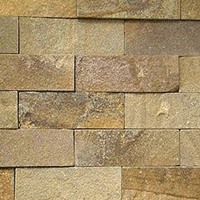 |
| Modules | Various tiles in standardized sizes |  |
| Plates | One-dimensional large slabs, usually made of marble |  |
In general, there are no restrictions on the shape of the stone - if only there was money and desire. No one will stop you from cutting out the same sandstone in the shape of a honeycomb, but in this case the natural charm of the stone will disappear behind the artificiality of this shape.
There are also a great many types of masonry. The same noodles can be laid strictly horizontally or alternate vertical and horizontal laying. Bricks of different sizes can be laid at random and “have fun” as you please - after all, this is cladding.
Color and texture

Even in the varieties, we looked at approximately what the colors and textures of facing stones are, and there is no point in chewing on this issue. However, keep in mind that natural stone is also very diverse.
Stone and not so much
Of course, you are free to choose what material to use for cladding your house. But if we were able to reveal the stone for you from an unexpected and attractive side, then do not rush to leave: in the following articles we will talk about the features of facing stone in different interiors, inside and outside the house.
Fake diamond widely used for cladding and interior decoration. The decorative capabilities of artificial stone, imitating the color and texture of natural stone, have long been deservedly popular among both builders and designers around the world.
What's happened decorative facing stone?
This is an artificial stone that reliably reproduces the shape, color and texture of natural stones: smooth and stratified, sawn and chipped, river boulders and pebbles. Its main components are cement (as a binder), sand, various fillers (expanded clay, perlite, pumice or mixtures thereof) and pigments. Sometimes, in order to improve the properties of the stone, plasticizers and antifreeze additives are introduced into its composition.
To make artificial stone, two types of cement are used - gray and white, and the price of the latter is much higher. White is used to create light collections, and therefore they are more expensive than their “gray” counterparts, but manufacturers are trying to reduce this price gap. Among the well-known Russian companies producing decorative facing stones are Kamrock, “Our Stone”, White hills, Chelsea Stone, Foreland, “Ekolit-trade”, “Ideal Stone”.
What are the characteristics of decorative facing stone?
The assortment of each company includes more than 20-30 collections of artificial stone, differing in natural prototypes and colors, several varieties of thin-walled facing bricks, various decorative elements, original paving slabs, paving stones, curb stones and flashings. Unlimited freedom to choose textures and colors helps to create real miracles with the facades and plinths of the most ordinary buildings, to modify landscape architecture objects - grottoes and retaining walls, rock gardens, paths, transform walls, fireplace portals, columns and other interior details in an unexpected way. All that remains is to decide on the design of the artificial stone collection and the decor, and then carry out the cladding in a manner traditional for the chosen style.
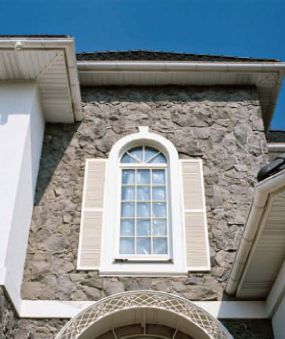
What is the technology for facing with decorative stone?
Working with decorative stone is not at all difficult. The main thing is to outline horizontal lines and strictly adhere to them. One caveat: if the house is on a hill, when finishing a wall located along the slope, you cannot lay stones along the ground line, which is sometimes practiced by careless workers, but only horizontally, cutting off the lower elements. From an architectural point of view, cladding looks most advantageous with the correct ratio of the sizes of the stone elements and the scale of the structure. It is no coincidence that for interior decoration it is recommended to purchase collections consisting of small stones; large ones look more natural and organic on the facades of buildings.
The optimal dimensions of the elements are selected using computer modeling programs. When developing collections of artificial stone, manufacturers take into account the ease of working with the material and try to minimize waste. Therefore, most rectangular elements have multiple sizes, and those of different sizes are modular. That is, on an area of 1 m² they can be laid without trimming, which means; there will be no waste. In addition, it is important to calculate how many large and small stones 1 m² or one package can hold. You should not save on purchasing corner elements included in all artificial stone collections. Otherwise, no matter how beautifully the walls of the house are decorated, one glance at the corner where the material is joined end-to-end will dispel the illusion of naturalness and volume.
![]()
What are the features of installation and use of stone cladding?
In order not to lose the warranty provided by the artificial stone manufacturer, you must follow certain rules for its installation and operation. This will save you from mistakes, and will also save you from the material and time costs of correcting them. First of all, you need to remember about the shrinkage of the building. There are different construction technologies and structural materials, so the degree of shrinkage of each structure is an individual value. Obviously, you should not start finishing the house, both external and internal, until the shrinkage processes are completed, because as a result, the cladding may crack or even fall off. The requirement to comply with the relevant SNiPs also seems natural. Thus, in the absence or incorrect installation, rain and melt water flows directly along the facade, shortening the life of the stone finish. Do not allow the material to come into contact with chemicals. Big problems arise in Lately with the advent of highly active anti-icing compounds. The contact of such compounds on the surface of a stone, especially in the first year of its operation, can lead to destruction in the first winter; a number of natural stones (marble, limestone, etc.) also have this problem.
What materials are included in decorative stone besides minerals and what affects the cost of the product?
Cement, sand, filler, pigments and additives. The price can change by 1.5-2 times and even a little more. Cement is its brand (sometimes it can be imported, for example, white Portland cement from Horse or Alborg White, which have the highest degree of whiteness. Even Turkish cement is not always suitable. Fillers - washed sand, vermiculite, expanded clay - expanded clay, perlite or foamed granulated glass. The latter is the most expensive, but it significantly simplifies the product and gives the highest stability over time. And, of course, the technology and qualifications of the workers. Moreover, the cost is completely determined by the size of the stone: the thicker it is. and the larger, the more expensive, as well as the complexity of the color and pattern of the stone. The price is determined not only by the composition of the materials, but also by the equipment and equipment used, in particular the casting mold. So, it can be plastic, which means it’s cheaper, but it will be a mile away. It is clear that the stone is artificial. But it comes from special varieties of silicone and polyurethane, and then the decorative stone cannot be distinguished from natural. The dye may be of unknown origin or, for example, from Bayer, which affects both the color saturation and its color. stability.
Does the degree of granularity of its structure affect the quality of decorative stone?
By and large, it shouldn’t, since the strength properties of a material depend on the homogeneity of its structure. The components must be well mixed when making the stone, and the degree of granularity is determined to a large extent by the size of the filler (small expanded clay balls, foam glass particles, sand).
Which artificial stone is more practical to use - with a smooth or textured surface?
The type of surface affects its external perception rather than its performance characteristics. A rough, embossed surface makes a decorative stone similar to a wild natural analogue, while a smooth surface resembles the same analogue, but after pre-treatment. In order to increase the performance properties of the stone, it must be treated with a high-quality water repellent. The type of surface affects its external perception rather than its performance characteristics. A rough, embossed surface makes a decorative stone similar to a wild natural analogue, while a smooth surface resembles the same analogue, but after pre-treatment. In order to increase the performance properties of the stone, it must be treated with a high-quality water repellent.
Is it possible to determine the quality of a decorative stone by its appearance?
Some people think that you need to look at the stone “for fracture,” but this is not entirely true. Not all manufacturers paint the stone “in bulk”; there are also those who cover only the front surface with a layer of paint several tens of microns thick. It is better when the pigment is added to the solution during mixing, so that the entire volume of the stone material is colored. Externally, one can only determine the attractiveness of the texture and color range, and the quality of the stone will be determined during operation. Great importance plays the opinion of people, for example neighbors, acquaintances or relatives who already have experience in finishing with stone from this company. If a stone can be easily broken when purchased, then this suggests the level of its quality. Facing stone good quality breaks with great difficulty.
Are there differences in the choice of decorative stone for interior and exterior decoration?
If we talk about the appearance of the products, then this is a matter of taste. The only thing that can be recommended is to carefully select the surface of the stone for the interior in order to eliminate defects that are noticeable at close range. When decorating the façade of a building, they will not be so conspicuous. But the requirements for frost resistance of external cladding come to the fore. In addition to the laws of architecture, there are also certain rules for combining stone textures and colors that the customer must take into account; it is also preferable to listen to the advice of the architect. Unfortunately, these laws and regulations are often violated, to put it mildly.
What is the frost resistance of decorative artificial stone?
Let me remind you that this term means the number of cycles of the outside air temperature passing through 0 ºС, during which the stone will retain its strength and will not collapse. This indicator is quite relevant for the Moscow region. GOST provides two indicators related to the impact of precipitation on products - moisture absorption and frost resistance. The first of them is not very important for concrete, and the second is strictly regulated by freezing and thawing cycles, the number of which for decorative stone must be at least fifty. Since in middle lane In Russia, 4-5 such cycles are observed annually, hence the warranty period for the stone is about 10 years. However, most samples of these products can withstand 100 and even 150 cycles.
How long does artificial stone last after production?
Like all concrete-containing materials, decorative stone must sit for at least 28 days, after which it gains 98% of its strength and can be sold. Since the stone is used as a decorative covering and is not a load-bearing element of the structure, during the most intense moments of construction, we ship the stone within 2 weeks. Theoretically, all processes of forming the structure of concrete are completed after 3 years, and its properties become unchanged. Taking into account the fact that the season suitable for performing external work in our latitude is short, hyperplasticizers are used, which accelerate the development of strength and thus the products can be shipped in a week, which corresponds to 70% of the strength of the final product and GOST for the shipment of concrete products.
Is there a classification of decorative stone by shape?
I can’t give a strict classification, but we can distinguish artificial stone of regular shape (for example, “Old Fortress”, “Estate”), irregular shape (for example, “Cascade”, “River Boulder”), layered stone (for example, “Rocky Pile” , “Thin layer”) and “ facing brick" The sizes of stones vary in thickness - from 0.7 to 10 cm and in area - from 5 to 50 cm².
What variety of stone textures is considered sufficient for a cottage?
It all depends on the area of the cladding and its location - in the interior or exterior. For a cottage this is 3 m² at interior decoration and 5 m² - for outdoor use. For large areas in industrial and residential buildings, the numbers are somewhat different.
Is the adhesive suitable for ceramic tiles and decorative stone?
No, other adhesives are used to attach the stone, characterized by increased adhesion values and setting time. This is explained by the fact that stone fragments have to be moved longer to find a place for them on the surface, and they are also heavier than tiles.
Can efflorescence appear on a surface covered with stone?
In Germany, a fairly substantial prize has long been offered to anyone who finds a radical means of preventing it on surfaces containing concrete. I would like to note that simple precipitation on the stone is not dangerous, but water seeping down the wall or poor waterproofing will lead to the formation of efflorescence. It makes no sense to consider the general construction problem of ensuring proper waterproofing here, since it is associated with a large number of factors and is solved differently for the foundation, plinth and walls. When they start decorating with decorative stone, it’s too late to talk about it - it must be completed.
What are the conditions for exterior finishing?
The air temperature should be +10 °C, although +5 °C is allowed, but still +10 °C is better. The surface to be decorated should be protected from precipitation. Only in this case is standard quality guaranteed. However, there are examples of finishing at sub-zero temperatures, but the conditions created in this case significantly increase the cost of the process. It is necessary to arrange so-called “warmhouses”, when a fragment of the surface to be finished is protected from the surrounding air, and a heat gun is turned on to increase the temperature inside such a shelter. In addition, it is necessary to use special additives to the adhesive composition.
What are the features of stone cladding of fireplace portals and chimneys?
Since the stone is non-flammable and does not emit any harmful substances, then the main problem when finishing a fireplace is correct selection adhesive mastic that can maintain the strength of the connection at high temperatures. First of all, such mastic should not produce cracks, which reduce the reliability of fixation. There are no special requirements for the size and thickness of stones in in this case No.
How can you minimize stone waste?
When facing a cottage, the optimal solution is to provide 5-10% for waste in advance, since waste-free use of the material is only possible when carrying out work on large area or on simple surfaces. For example, when finishing a fence around a cottage village, when the area is measured in thousands of square meters, you can achieve a waste of 1-2%.
Is it possible to seamlessly lay decorative stone?
According to SNiPs, an expansion joint must always be provided and be at least 7 mm. It is not only designed to compensate for temperature deformations, but also takes into account the uneven edges of the decorative stone. They always dissuade customers from seamless installation, which causes a lot of trouble in the future during operation. I would like to note here that the adhesive solution should be applied to the entire back surface of the stone in order to eliminate air “pockets” that could cause the stone to fall off.
How much will it cost to install decorative stone by specialists?
Surfaces in interiors are usually prepared much better than facades, so work on preparing them and laying stone can cost 40-350 rubles/m². Exterior surfaces often have to be leveled and prepared before laying the stone, so the cost of work here can be 600-1500 rubles/m². This does not take into account the number of floors, the presence of columns, portals, windows and doors.
Is it possible to make three-dimensional figures from artificial stone - family monograms, bas-reliefs, statues?
You can do anything. But first you will have to make a special flexible form, the cost of which for a single copy will be quite expensive. Not everyone can afford this. Almost every company has modelers who can make a fairly complex shape, sometimes using a computer program. Not everyone can afford such expenses.
How to care for stone cladding during use?
After laying, a special water-repellent composition is applied to the decorative stone - a water repellent, which can be based on silicone, varnish, etc. The first gives the surface a matte appearance, the second - gloss, but over time this coating is destroyed, so after 4-5 years the treatment will have to be repeated. Moreover good compositions must create a film that does not prevent air from entering under it, so that the stone “breathes.” To remove dust and restore the original, brighter color of the cladding, it must be periodically washed with a stream of water under pressure, but not sandblasted.
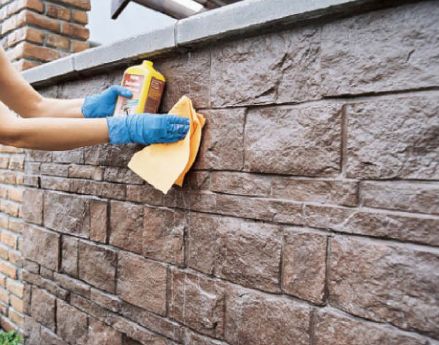
What are the advantages of decorative stone over other materials, such as its natural counterpart?
Firstly, decorative stone is much cheaper than natural stone. Secondly, you can always choose exactly the color and even shade that is required. It is more homogeneous and does not have the flaws inherent in natural material. It is much easier to care for. Again, you can save on shipping if the product is made in a nearby factory. In addition, it can be purchased in any quantity at any time. Facing made from such stone is easy to repair. It is approximately 1.4 times lighter than its counterpart with the same texture. In addition, artificially aged decorative stone does not lose its consumer properties at all, while for natural stone, natural aging means impending destruction. And finally, special additional elements greatly simplify installation.
Stone is an integral component when creating an original interior. It is obvious that this natural material has always been highly valued, and recently its cost has also increased significantly. The thing is that this finishing resource is incredibly in demand, and it is often used in large projects where there is a need to use a large amount of stone.
But don’t forget about artificial stone. Many people mistakenly believe that it is better not to resort to this option, but practice shows that in most respects, artificial material is no different from real stone. Moreover, decorative material can simply have an amazing appearance, shape and, of course, texture.
It is interesting that recently small production facilities have been producing decorative materials. We are, of course, talking about handicraft production. It is quite possible to make a decorative stone with your own hands. There is nothing complicated here. Moreover, this is a fairly inexpensive process, so there are no restrictions in this direction. It all depends on existing resources, capabilities and, possibly, imagination.
Now we will look at the main features of the decorative material, and also try to analyze the main stages of producing this product with our own hands.
Main features of decorative stone
It’s worth saying right away that decorative stone differs from natural stone, first of all, in appearance. Obviously, most often artificial material is produced in the form of bricks and small tiles. At the same time, natural stone is available in the form of ordinary blocks, which also look good in the overall interior of the home. Accordingly, for many people decorative stone is preferable, since it has fixed dimensions, a strict appearance, and is also directly suitable for construction process.
Accordingly, each owner, having familiarized himself with the dimensions of the decorative stone, can draw up a plan for finishing the wall. It's incredibly convenient and really practical. There are a huge number of finishing options available online, and it is on such options that you can base your decision regarding finishing work.
Advantages of artificial stone over natural stone
As we have already said, for the average home artificial stone is more practical option than natural material. And in this case, several reasons need to be noted:
- Price question. Obviously, artificial material is cheaper than natural one. Moreover, in modern conditions the difference between these two options is simply colossal. Also, do not forget that for the same money you can buy much more artificial product than natural one. Accordingly, you can significantly increase the finishing area. And, of course, it is worth saying that now people are trying to save on everything, so such savings are definitely pleasing.
- Material weight. Natural stone is much heavier than artificial stone. Accordingly, if we are finishing a room, then the decorative material in this regard is much more reliable and practical. Moreover, in such conditions, you need to take seriously the material with which the stone will be fastened. For example, to install natural material durable cement is used, but artificial stone can be attached without problems using liquid nails and other types of glue. In this case, you can also see considerable savings, as well as take care of the pleasant appearance of the finish.
- Transportation. Considering that natural stone has enormous weight, it is much more difficult to transport than decorative material. Moreover, this applies not only to the transportation of products by specialized logistics companies. Many owners use their own strength to deliver the necessary cargo to their home. Accordingly, in such cases (when delivering natural stone), you will either have to use large transport, or divide the entire volume of material into several parts if there is a lot of cargo and it is heavy. With artificial stone everything is much simpler. Most often, such a product has special packaging, which is incredibly easy to transport over long distances, even if we have a small car at our disposal.
Decorative stone also has its disadvantages. For example, we can note the high abrasion of surfaces, but this is only if we use artificial material as a floor covering. In addition, under the influence of ultraviolet light, the image on artificial stone may fade slightly. Exposure to sunlight should be avoided. In any case, the above points cannot be considered significant shortcomings.

Types of artificial stone
There are many varieties of artificial stone on sale. In some cases, this material is very difficult to distinguish from natural stone. This, most likely, is the main advantage of an artificial product.
You can often find crushed stone on sale. Using a regular hammer, the manufacturer ensures that the stone looks as close as possible to its original appearance. Small chips only add to the attractiveness of this product.
Sawed stone. In this case, the artificial material can be filed, and ultimately we get even smooth edges, which are characteristic of high-quality paving slabs. This is also a good option for those who want to tile their walls.
Rubble stone. These are the most common forms for natural stone, but to achieve a similar result for the production of artificial material, special forms are used. Accordingly, in this case we get the most ordinary boulders.
Decorative material. This is the most common variation of artificial stone. Each unit of such a product has a fixed size and a memorable shape. For decoration, this option is also optimal because, based on the presented dimensions of the stone, we can draw up a sketch and a complete plan for finishing work.

Materials for making artificial stone
Of course, there is no single material for the production of artificial stone. Sometimes cement mortar is used for this, and sometimes gypsum or even alabaster is an excellent option. Also recently, decorative stone has been made based on polymer materials. Ultimately, the quality of such a product is very high, just like the cost.
The good thing is that almost anyone can engage in the production of artificial stone. To do this you do not need to have a construction education or great experience. After the first manufactured product, everything immediately becomes clear.
Of course, in artisanal conditions it is best to produce artificial stone based on cement or gypsum. These are the most optimal and inexpensive options. If there are any problems associated with the process of creating a stone, you can not despair and try again.
Forms for the production of artificial stone
Regardless of what material is used to create artificial stone, there is a need to purchase a mold in which our product will be cast. For a full-fledged construction process, it is necessary to have several forms that allow you to quickly lay stone. It is advisable to purchase identical forms that match both in size and style. However, more original solutions can be applied. For example, some owners use 3 different options shapes that perfectly complement each other, create an original cladding style.
Most often, molds for artificial stone are made from silicone. This is a practical material that does not have any disadvantages associated with the production of stone. All these forms are quite soft and bendable, so during the production process of the material you need to keep this in mind, since it is very easy to damage the product.
If there is an opportunity or desire to create your own forms for the production of artificial stone, then there is nothing complicated here either. You just need to make a small formwork that will have the shape of a box. At the bottom of the box we place several stones (about the same size), which will serve as a model for creating the shape. Now you need to arm yourself with silicone and fill the box with it (a few centimeters). After some time, the silicone material is removed, and the voids created are a kind of stencil for releasing the stone. However, you need to know that in this case a lot depends on the choice of stone (sample). This natural resource should have an attractive shape and no sharp edges. The mold making process often takes up to three weeks, with the longest wait for the silicone to dry. After this, the created formwork is disassembled, and the form becomes suitable for use.

Artificial stone made of cement or gypsum
- Cement based. If you decide to make cement-based artificial stone, you should start the process by mixing sand and cement in a ratio of 1 to 3. These ingredients are mixed until smooth, after which water is added. After this, the state of the mixture should correspond to the consistency of sour cream. Next, you can safely fill the molds with the prepared mixture. It is worth keeping in mind that the mixture must be slightly compacted so that no voids arise inside that negatively affect the appearance and condition of the future product. After about 10-12 hours, the stone can be removed from the mold, but it can only be used in construction after a couple of weeks.
- Based on gypsum. In many ways, the process of producing artificial stone based on gypsum is similar to what we discussed in the previous paragraph. However, attention should be paid to the fact that the hardening process of gypsum occurs much faster. Accordingly, after 30-40 minutes you can remove the product from the mold. You must first lubricate the stone mold with oil so that the product can then be easily removed. It should be noted that cement stone is more practical than gypsum stone. The thing is that cement-based stone, among other things, can also be used as exterior decoration.
Production of artificial stone and dyes
Obviously, you can’t do this without dyes, otherwise you simply won’t be able to create an original design.
In some cases, the stone is painted after production. This is the simplest method, but it is not very practical, since the external appearance of the product may not look very presentable. To do this, we just need to clean the stones from dirt and dust, after which a thin layer of paint is applied to the stone with a brush (several layers can be applied).
However, most often the coloring of the stone occurs directly during the production of the material. As an example, let’s analyze the features of using dye when creating cement-based stone:
- The dye is added to the cement while mixing the mixture. Most often, the optimal volume of dye is 3% of the total volume of the mixture. Of course, it is necessary to thoroughly mix the material so that the mixture is homogeneous.
- Now the molds are filled approximately halfway with the mixture. If everything is done correctly, the cement must have the appropriate color.
- The second half of the mold can be filled with ordinary cement mortar, since there is simply no need to use too many dyes. A metal mesh should be placed on the surface of the colored solution, which will ensure high strength of the material.
At the very end, it wouldn’t hurt to apply a small texture on the top layer of the solution, which will allow the material to better adhere when covering the surface.
The most important thing is the time that you need to wait before the finishing material can be used in the process of finishing the walls. If everything corresponds to the technology, then the artificial stone will be strong and durable.


